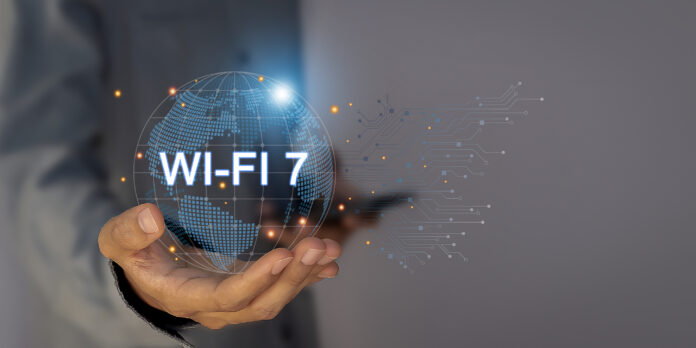With powerful features like 320 MHz channels, 4096-QAM modulation and Multi-Link Operation, Wi-Fi 7 has been positioned as a potential game changer for IoT
The latest numbers for global connected Internet of Things (IoT) devices show a rapidly expanding ecosystem. According to IoT Analytics, there are approximately 18.8 billion IoT devices globally, marking a 13% increase from 16.6 billion in 2023. This growth trend is expected to continue, with projections estimating that the number of IoT devices will reach 40 billion by 2030. With powerful features like 320 MHz channels, 4096-QAM modulation and Multi-Link Operation (MLO), Wi-Fi 7 has been positioned as a potential game changer for IoT as it promises to deliver the faster, more reliable, more energy efficient and lower-latency wireless connectivity that emerging — and more advanced and data-intensive — IoT applications require.
According to Quectel’s Wi-Fi Product Manager Lazaros Kapsias, MLO is a crucial enhancement for IoT because traditional Wi-Fi devices could only connect to a single band at a time. “With Multi-Link Operation, an access point is no longer restricted to communicating with a station on a single band or channel. Instead, both can use multiple channels simultaneously, enabling load balancing and dynamic interference mitigation,” Kapsias told RCR Wireless News, adding that one example includes a latency-sensitive VoIP connection moving to a low-interference channel, while a large file transfer can be distributed across two bands.
“As a result, MLO not only increases overall speed but, more importantly, reduces latency and enhances reliability. This makes it ideal for emerging applications such as VR/AR, online gaming, remote work and cloud computing,” he added.
Wi-Fi 7’s 320 MHz channels and 4096-QAM modulation provide up to four times the capacity and data rates compared to Wi-Fi 6. This is particularly beneficial for IoT applications that require high data throughput, such as smart factories leveraging real-time AI-driven automation and healthcare IoT devices transmitting high-resolution patient data.
Kapsais did note that access to the 6 GHz band is necessary to achieve the congestion benefits from 320 MHz channels. While Wi-Fi 6E introduced 6 GHz, Wi-Fi 7 fully leverages it for channel bonding and interference reduction, making it ideal for high-density IoT deployments. “Most notably, 320 MHz contiguous channels can only be achieved within the 6 GHz band — three non-overlapping ones are available in some regions,” he said.
Kapsais additionally pointed out that higher data rates are not necessarily the most critical benefit for IoT. “The reality is that the data rates of Wi-Fi 6/6E — let alone Wi-Fi 5—are already more than sufficient for the vast majority of IoT applications,” he explained. Instead, he reiterated the Wi-Fi industry mantra that the real advantage of Wi-Fi 7 lies in its efficiency and reliability.
Traditional Wi-Fi networks struggle with unpredictable latency, which can disrupt time-sensitive IoT applications. Wi-Fi 7 introduces deterministic performance, ensuring that data is transmitted with minimal jitter and packet loss. This is particularly important for:
- Industrial IoT (IIoT): Enabling precision robotics and machine-to-machine (M2M) communication in manufacturing.
- Autonomous vehicles: Supporting real-time V2X (Vehicle-to-Everything) communication for safer transportation systems.
- Smart homes & healthcare: Guaranteeing uninterrupted operation of critical systems like security alarms and remote patient monitoring.
Further, Wi-Fi 7 will also mitigate network congestion as more and more IoT devices are connected thanks to the standard’s enhanced Orthogonal Frequency Division Multiple Access (OFDMA) and Multi-User Multiple Input Multiple Output (MU-MIMO), which allows multiple IoT devices to communicate simultaneously without interference and adaptive preamble puncturing, which enables better spectrum utilization, especially in environments with competing wireless signals.
Ultimately, Wi-Fi 7 is poised to become the backbone of next-generation IoT deployments; however, Kapsais emphasized that its adoption in IoT may take longer than expected. While high-end consumer devices are already integrating Wi-Fi 7, many IoT products are still transitioning to Wi-Fi 6/6E. “For most IoT products, Wi-Fi 7 will only become relevant in their next design cycle — likely two to three years from now,” he said. “I don’t expect Wi-Fi 7 to become the dominant Wi-Fi technology in the IoT segment, in terms of units sold per year, much earlier than 2030. If we extrapolate this trend to Wi-Fi 8 — based on historical adoption patterns — the corresponding timeframe is likely somewhere between 2035 and 2040.”

